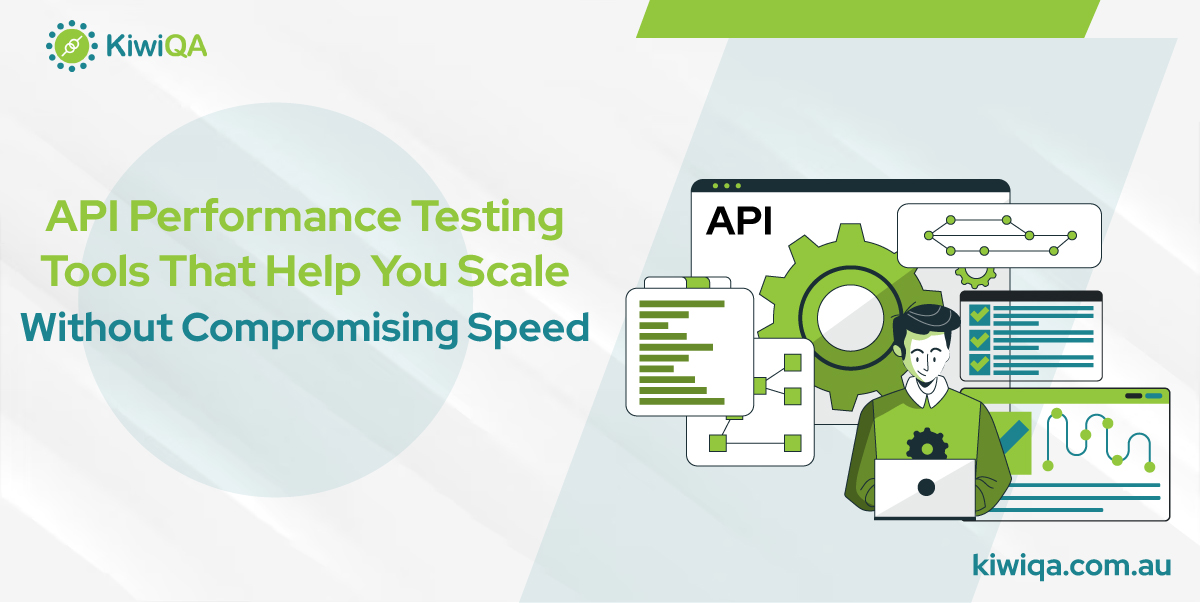API Performance Testing Tools That Help You Scale Without Compromising Speed

Now that IT landscapes have become dependent on APIs, performance testing has become a necessity in the development process. APIs are the advanced solution of modern applications, facilitating seamless connections between various software systems. The demand for scalable & robust APIs continues to grow, and that’s why the popularity of API performance testing is growing. By 2033, the global API testing market is expected to have grown significantly, from USD 1.5 billion in 2023 to USD 12.4 billion.
The testing assists in tracking the potential errors that can cause errors and verifying that the API can manage high load without compromising user experience. API performance testing includes simulation of various requests to measure how well the API manages various levels of load & matches the demand of end users in real-time. This comprehensive guide covers top API performance testing tools, offering developers & QA professionals an advanced solution to optimize API performance.
The number of API queries rises in tandem with the user base. Performance deterioration, timeouts, and even system failures could result from the API and its supporting architecture being unable to manage the additional load without optimization.
A timeout error may occur if the client application reaches its configured timeout limit and ends the request because the API is taking too long to answer. During processing, unoptimized APIs may use unnecessary server resources.
APIs that aren’t optimized can cause major bottlenecks, especially when there is involvement of third-party dependencies. It can cause a lower performance rate & bad user experience.
When one server receives excessive traffic while other servers are left underutilized, poor load balancing can result in API slowdowns. This results in bottlenecks during spikes in traffic, which lowers performance and raises API request latency.
The real cause of poor API performance is ineffective database queries. Inaccurate filtering and poorly constructed SQL queries can greatly lengthen processing times and data transfers.
An uncached API endpoint is a major contributor to API lag since each request needs to be handled entirely from the beginning, requiring database queries and other processing effort.
The speed and dependability of the client and server’s internet connections have a direct impact on network latency. A poor connection will undoubtedly lengthen the time it takes for data to travel.
The great API performance testing tools excel at simulating real-world traffic by providing a variety of features that closely match how users interact with the API in production. The tool should be capable of generating a large number of concurrent requests, simulating thousands, if not millions, of virtual users accessing the API at once.
The performance testing API tools should be able to generate a large number of concurrent requests, simulating hundreds or even millions of virtual users, in order to correctly simulate real-world traffic situations and stress the API.
A powerful web API performance testing tool excels at giving both real-time and post-run statistics to provide a complete picture of API behavior under varying loads. Real-time dashboards provide quick visibility into KPIs such as response times, error rates, throughput, and latency as the test is running.
The solution should provide native or easily configurable connectors with prominent CI/CD platforms. This allows for automated execution of performance tests.
Both scripting flexibility and no-code alternatives help to create an outstanding API performance testing tool, but their value varies depending on a team’s individual demands and skills. No-code interfaces make API performance testing more approachable. No-code tools are ideal for fast designing tests and studying API behavior without the need to write code.
The performance testing tools for API should manage a variety of API protocols, including REST, GraphQL, gRPC, and even SOAP, enabling testing across multiple architectural paradigms within an organization’s infrastructure. This limits the requirement for various tools and improves testing efficiency.
K6 is a modern, developer-focused quality evaluation tool that supports API quality verification at scale. It works on scripting based on JavaScript, and an emphasis on developer experience makes it an ideal solution for teams wishing to smoothly incorporate quality assurance into their development operation.
K6’s developer-friendly methodology and robust capabilities make it an ideal solution for teams wishing to shift left with performance testing, detecting, and resolving API glitches prior to the development process. K6 is famous among QA professionals because of its user-friendly dashboard and scalability, allowing customers to begin incorporating performance testing into their CI pipelines. It has a simple scripting API.
Use it if: Make sure your application can manage anticipated traffic by using the K6 tool for load testing, which includes stress, spike, and soak testing. Additionally, it is useful for end-to-end web testing. Choose these REST API performance testing tools if you want developer-friendly scripting and Git-based version control of tests.
Apache JMeter, one of the most effective performance testing tools available, was originally designed to assess load-balancing systems, but it is now used to test servers, websites, and apps of various types. It is one of the most powerful assessments because it has the potential to simulate a wide range of apps while also loading various sorts of data.
It enables QA teams to simulate large traffic loads, monitor throughput, response times, and error rates, and pinpoint performance bottlenecks across several apps. It inspects static and dynamic web, FTP, TCP, email, and database resources. It can simulate a network, servers, or objects in order to test performance against multiple load conditions.
Use it if: You need to test complex integrations with lots of protocols.
Newman is an accessible command-line collection runner for Postman that enables the execution and automation of Postman API test collections. Postman is a popular web API performance testing tool for development and functional testing. Newman expands its capabilities by allowing command-line execution, making it ideal for integration into CI/CD pipelines and automated testing workflows.
Newman enables users to run Postman collections straight from the command line, bypassing the Postman graphical user interface. This is critical for automation and integration with continuous integration environments. Newman integrates seamlessly with CI/CD tools, enabling API testing to be performed automatically. Newman encourages data-driven testing by permitting the use of external data sources.
Use it if: Blend both the testing tools if your team already uses Postman and needs basic performance testing.
Artillery is a free performance evaluation tool that works with HTTP, WebSocket, and Socket.io protocols. Artillery is a lightweight and scalable performance testing tool for web apps, APIs, and microservices. Artillery is a modern, robust, and easy-to-use load testing toolset for APIs, microservices, and webpages.
Its cloud-native architecture and adaptability make it an ideal choice for organizations working with distributed systems that want to incorporate performance testing into their CI/CD workflows. Artillery provides a versatile configuration and programming architecture that makes it simple to create and run complex test scenarios. Artillery offers real-time monitoring and reporting on test outcomes, including parameters like response times and mistake rates.
Use it if: Throughout the SDLC, artillery performance testing is used in a variety of situations to make sure that applications and APIs can manage both expected and peak loads. Great tool to maintain speed and simplicity without sacrificing scripting flexibility
Gatling is a Scala-based free API performance testing tool that can be used to test the load and performance of web apps. It supports the DSL language that helps QA experts build test cases while offering data and HTML reports. This popular performance evaluation tool enables you to automate load tests for enhanced performance.
Gatling is widely recognized as one of the top load testing tools in the market, owing to its performance and scalability testing features. Gatling’s user-friendly and extensive scripting capabilities allow testers to rapidly design complicated load scenarios. It’s particularly useful for assessing modern apps and APIs. While not totally free, Gatling’s open-source nature makes it an effective free performance testing solution for many businesses.
Use it if: Gatling’s asynchronous architecture makes it ideal for high-performance load testing, particularly when you need to effectively simulate a significant amount of concurrent users. Teams that wish to incorporate load testing into a CI/CD pipeline for contemporary web applications will find it suitable.
BlazeMeter is a powerful load evaluation platform that ranks as one of the quality load testing tools available. It provides a streamlined approach to performing performance evaluations on your apps and APIs in a distributed and scalable environment. BlazeMeter uses the power of the cloud to simulate large loads from several geographic regions, offering a quick measure of the app’s performance against multiple scenarios.
BlazeMeter’s cloud load testing features, available in both free and premium plans, make it an appealing alternative for organizations looking to improve the speed and stability of their applications. Its user-friendly design and rich reporting tools contribute to its popularity as a well-ranked load testing tool.
Use it if: When you require automated testing within CI/CD pipelines, simulate large user loads, or run tests in environments that are unavailable, BlazeMeter is a great tool to utilize for performance, functional, and API testing. It’s perfect for testing across platforms and making sure apps can manage high traffic volumes. Good to go if you need distributed testing and don’t want to maintain infrastructure
Continuous Integration & CI/CD have transformed the development and release of apps in the current tech world. Most of the time, however, application performance is overlooked in such pipelines, leaving teams vulnerable to major bottlenecks once the applications go live. Integrations allow you to detect issues early on, ensure scalability, and build confidence in each release.
Integrating performance testing with common CI/CD solutions allows teams to automatically evaluate application performance with each code change, resulting in a more consistent and dependable user experience. Future performance testing trends for CI/CD include greater automation and the involvement of AI-powered solutions.
As CI/CD pipelines require shorter testing cycles, AI and ML are being used to automatically detect anomalies, predict possible bottlenecks, and provide optimizations. This transition to “intelligent testing” allows performance tests to be more adaptive, focusing on areas that are most likely to cause problems, lowering total testing time while boosting reliability.
Teams may continuously evaluate the health of applications at every step of development by automating performance tests with performance testing tools for API, such as JMeter, Gatling, and LoadRunner. Teams can detect problems early, preserve release agility, and make sure apps are prepared to satisfy user needs by integrating these tests into CI/CD.
Throughout the scaling lifecycle, performance testing should be incorporated to guarantee that an application stays responsive, reliable, and fast as demand increases. Testing before, during, and after scaling helps in proactively assessing & mitigating any errors. Establishing a performance baseline, locating potential bottlenecks, and confirming the system’s stability under typical operating conditions are the goals of testing before scaling. This foundational effort confirms that the application’s core architecture can accommodate expansion in the future.
Scalability testing, sometimes referred to as testing during scaling, entails progressively increasing the user load or data volume to gauge the system’s performance as it expands. It confirms that the program can continue to function as it grows in size. It’s crucial to retest after implementing performance-enhancing improvements or scaling up infrastructure to ensure that the increased capacity and optimizations function as planned.
The demand on the API rises as applications broaden & gain more users. Even during periods of high usage, a scalable API can effectively manage an increase in requests without experiencing performance deterioration, guaranteeing a seamless user experience. When dealing with heavy traffic, non-scalable APIs may cause mistakes, sluggish response times, or even outages.
In order to prevent service interruptions and guarantee continuous operation, scalability helps in maintaining the API’s availability and dependability. The ability to integrate with new services or functionalities and adjust to shifting business requirements is made possible via scalable APIs. As a result, businesses may develop and grow without being constrained by the underlying API architecture.
You must test for resilience in addition to load if you want to create software that is genuinely robust and dependable. Resilience testing actively confirms a system’s capacity to bounce back from unforeseen failures and carry on under pressure, whereas load testing gauges performance under typical circumstances. For sophisticated, distributed systems that are subject to inevitable disruptions like hardware malfunctions, network downtime, and dependency failures, this strategy is becoming more and more important.
Maintaining the functionality, security, and health of contemporary software systems that depend on networked apps requires constant API monitoring. Many programs rely on APIs as their foundation. In order to reduce downtime and service interruptions that could affect user experience and business operations, ongoing monitoring ensures that APIs are constantly responsive and available. Continuous monitoring provides a quick identification of issues, such as performance deterioration, faults, or security vulnerabilities. Users are less affected by quick troubleshooting and resolution made possible by real-time notifications and thorough records.
A more thorough insight into user experience and system health can be obtained by combining synthetic testing & RUM, which offers a robust and comprehensive approach to web and application performance monitoring. In order to create performance baselines and facilitate comparisons across time, synthetic tests provide reliable, repeatable measurements of certain user flows and functionality.
RUM offers end-to-end visibility from the user’s point of view, capturing the unpredictability of actual user journeys and exposing bottlenecks and problems that might not be reproduced in synthetic tests. RUM data can identify trouble spots for actual users, which can subsequently be repeated and further examined with synthetic testing to identify and fix the underlying reason. Before being deployed to production, synthetic tests offer a controlled environment for testing solutions to make sure they successfully address the issues found.
When implementing changes in any setting, performance testing services are a crucial step to take. To increase app speed and dependability, the ideal solution should complement your architecture and offer useful insights. The significance of large-scale performance testing will only increase as APIs continue to be essential to contemporary software architecture.
The upcoming time for API performance testing tools is probably going to be shaped by rising trends like on-time performance assessment, AI-driven test generation, and integrating platforms. Development teams can make sure their APIs are reliable, scalable, and able to provide outstanding performance even in the most taxing circumstances by utilising these potent tools and methodologies.
To ensure the quality and dependability of your digital services, efficient API performance testing is a continuous process of optimization and improvement rather than a one-time event. The above list of REST API performance testing tools & tools mentioned in our other blogs will help you get started.
Subscribe to our newsletter for some hand-picked insights and trends! Join our community and be the first to know about what's exciting in software testing.
Welcome to the testing tales that explore the depths of software quality assurance. Find valuable insights, industry trends, and best practices for professionals and enthusiasts.

Fill out and submit the form below, we will get back to you with a plan.
 CRN:
22318-Q15-001
CRN:
22318-Q15-001 CRN:22318-ISN-001
CRN:22318-ISN-001 CRN:22318-IST-001
CRN:22318-IST-001